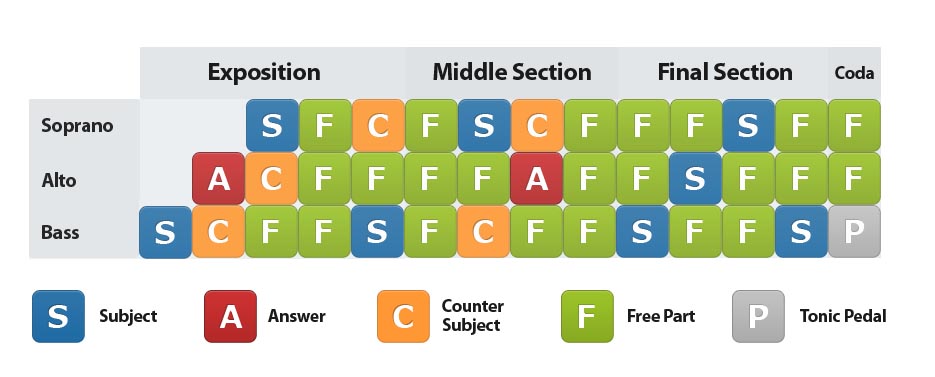A fugue is a piece of music of contrapuntal texture which is predominantly based on one theme called the subject. It’s important to note that a fugue isn’t really a form, it is a way of presenting a contrapuntal texture.
Overview
A fugue has three main sections, the Exposition, the Middle Section (sometimes referred to as the modulating section) and the Final Section. The sections in a fugue refer to contrasts in key rather than theme.
- The exposition begins the fugue and a single voice plays the subject establishing the tonic key. Another voice enters with the answer which is the subject transposed up a perfect 5th (or down a perfect 4th) into the dominant key. As the second voice plays the answer the first voice can play either a free part against it or a counter-subject.
- The middle section consists of entries of subject and answer in keys other than the tonic separated by episodes. An episode is a modulating link between the entries of the subject and answer to make a change from continual reiteration of the subject. They are usually based on a figure from the subject or counter-subject.
- The final section begins where the subject or answer returns in the tonic key. The section will contain at least one entry of the subject in the tonic and will usually end with a coda (which can vary from a few notes to a few bars).
Here is an example of a fugue structure:
Techniques
During the middle and final sections, various “fugal devices” may appear. They are:
- Stretto
- Augmentation of the subject
- Diminution of the subject
- Inverse movement
Stretto occurs when entries of subject and answer overlap each other, the second beginning before the first is finished. A close stretto is one in which the overlapping is considerable.
Augmentation of the subject means statement of it in notes of greater value, usually double.
Diminution of the subject means statement of it in notes of smaller value, usually half.
Inverse movement means statement of the subject upside-down, upward intervals become downwards ones and vice versa. This is sometimes called “Inversion” but “Inverse Movement” is a preferable term since it avoids any possible confusion with inversion of subject and counter-subject.
These devices can be used in combination, e.g. the subject can appear simultaneously in Augmentation and Inverse movement (its notes are twice as long and upside-down).
Summary
Utilizing the techniques above and the example structure you’ll be on your way to writing your first Fugue. In the future we’ll be giving a step by step guide to writing your fugue beginning with constructing your subject. Stay tuned!






